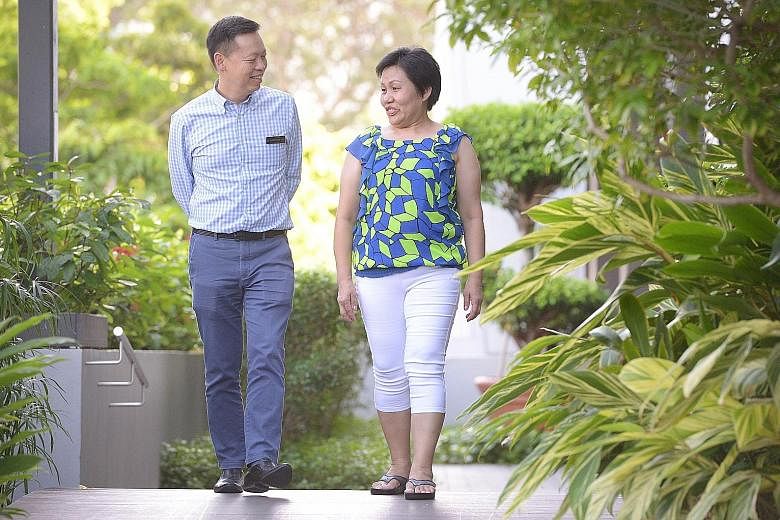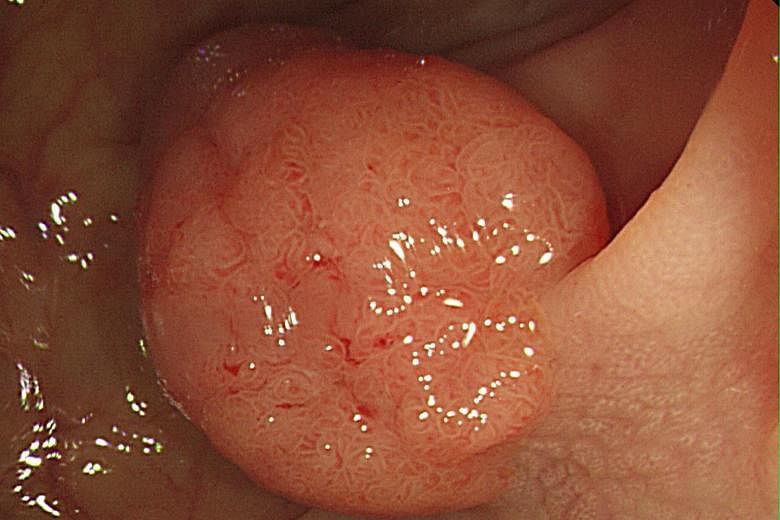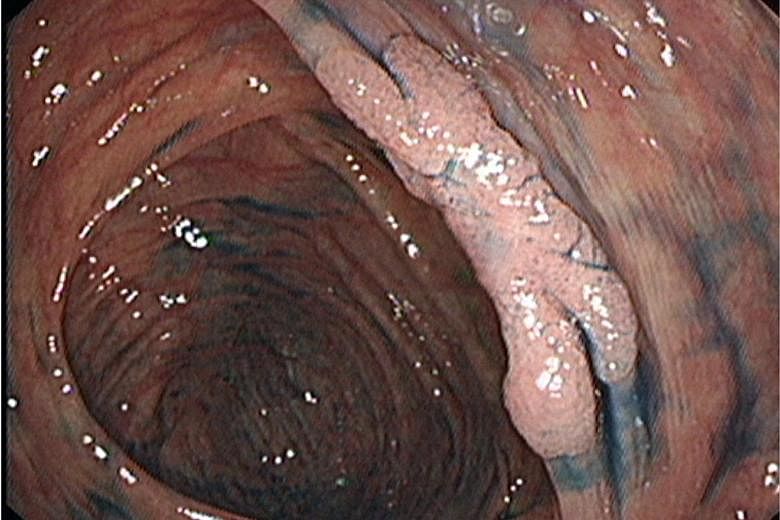After she went for a routine colonoscopy last year, Madam Man Yee Fun received some unwelcome news. There was a polyp - which could become cancerous - in her colon, and it was an unusual one.
It was "flat" against the colon wall, unlike the more common ones which "stand up".
Such flat polyps are more likely to harbour early cancer.
They are also more difficult to remove because the colon wall is so thin.
Madam Man had a second procedure scheduled with another specialist to remove it.
"My doctor said a solution was injected below the polyp to lift it off the wall of the colon before they could remove it," said the 56-year- old mother of three.
-
PUBLIC FORUM
-
Find out more about colorectal cancer symptoms, prevention, risks and treatment from medical experts.
DATE: Next Saturday, March 5
TIME: 9 to 11.30am
VENUE: Academia Auditorium, 20 College Road, Singapore 169856 (opposite SGH Block 7)
REGISTRATION DETAILS: Admission is free, seats are limited and pre-registration is required. To register, call 6576- 7658 from Mondays to Fridays (9am to 5.30pm) or e-mail your full name & contact number to public.forum@sgh.com.sg.
Increasingly, research has shown that a significant minority of at-risk individuals may have flat polyps.
These grow along the intestinal walls and are almost indistinguishable from the surrounding tissue.
Unlike the conventional polyps which look like guys standing up in the colonic landscape, flat polyps look like guys lying down on the floor, said Dr Vikneswaran Namasivayam. He is a consultant in the department of gastroenterology and hepatology at Singapore General Hospital (SGH).
Flat growths on the colon wall are also more common than doctors previously thought, he said.
They were first reported by the Japanese in the 1980s and were then believed to be peculiar to the Japanese. However, studies elsewhere showed otherwise.
Endoscopists (doctors who put instruments with a camera into a natural opening of the body) in Singapore were probably first aware of flat polyps in the 1990s and have since been vigilant in looking out for them during colonoscopies, said Dr Ho Kok Sun, a general surgeon at Mount Elizabeth Hospital.
Although doctors have long known about these growths, their danger was not appreciated until quite recently.
A 2008 study in the United States, reported in the Journal Of American Medical Association, found that almost one in 10 people with polyps has the flat type.
Researchers discovered that flat growths are nearly 10 times more likely to be cancerous than stand-up polyps.
In Singapore, there is no data on how many flat polyps are found versus conventional ones. Population studies around the world have shown that approximately one in 10 patients who have colonoscopies as outpatients has flat colon polyps.
Last year, more than 2,500 colonoscopy procedures involving polyp removal were done at SGH, out of a total of 10,000 colonoscopies in patients aged 50 years and above.
Dr Roy Muljadi Soetikno was the lead investigator in the 2008 US study. He is now a senior consultant in the department of gastroenterology and hepatology at SGH and a visiting consultant at the National Cancer Centre, Singapore. He said that before the study, doctors performing colonoscopy would just look for the obvious and protruding polyps.
"They did not have a good reason to look for the less obvious polyps - the flat ones have similar colour as the colon wall," he said. Specialised training is required to detect them consistently.
Giving details about the study he led, he said it involved colonoscopies of more than 1,800 patients, mostly men, from July 2003 to June 2004. Doctors involved had been trained by Japanese specialists to use a dye during colonoscopies to spot flat growths.
"We imported the technique from them and used it on Western patients. But as we were in California, we had many Asian patients too," said Dr Soetikno, who was professor of medicine at Stanford University.
One-third of the patients in the study were going in for routine screening. The rest either had symptoms such as bleeding or pain, or were screened because they had previous polyps or a family history of colon cancer. Flat and depressed growths were detected in 170 patients, nearly 10 per cent, while stand-up polyps were found in 675 patients, about 37 per cent.
Since then, other researchers have found that the flat growths appear to represent a separate colon cancer pathway, rather than being precursors to regular protruding polyps.
The US study pioneered changes in how colonoscopy is performed today around the world.
"When our study came out, suddenly not only doctors but also patients understood the importance of having a good-quality colonoscopy," said Dr Soetikno, who started working here early last year.
The most difficult part of a colonoscopy is the bowel preparation before it, he said. If the bowel is clean of faecal matter, then doctors can perform a detailed examination to find flat polyps, he said.
Undetected or missed, the flat polyps can become cancerous.
Thus, undetected flat polyps could explain some cases of "interval cancers" that show up between screenings in people who were told they had a "normal" colonoscopy, said Dr Soetikno, who is also an adjunct professor at Duke-NUS Medical School.
The high rate of cancer in the flat growths also warrants further research. Though studies have shown that more of the flat polyps are malignant, it remains unknown why.
Dr Ho said it could be because such polyps are more aggressive and predisposed to turn into cancer, or because they are more easily missed and hence have a longer time to turn cancerous.
Colon cancer is the No. 1 cancer here. But Dr Christopher Khor, head and senior consultant at the department of gastroenterology and hepatology at SGH, said this deadly cancer can be prevented.
He advised people to ask for screening after age 50 and, if there is a family history of colon cancer, then screening should be done at an earlier age.
Madam Man now intends to have a colonoscopy performed at scheduled intervals recommended by her doctors. "When the doctors found my flat polyp, they said I was very lucky. If it had not been found, it would have turned cancerous within the next year or two," she said.




